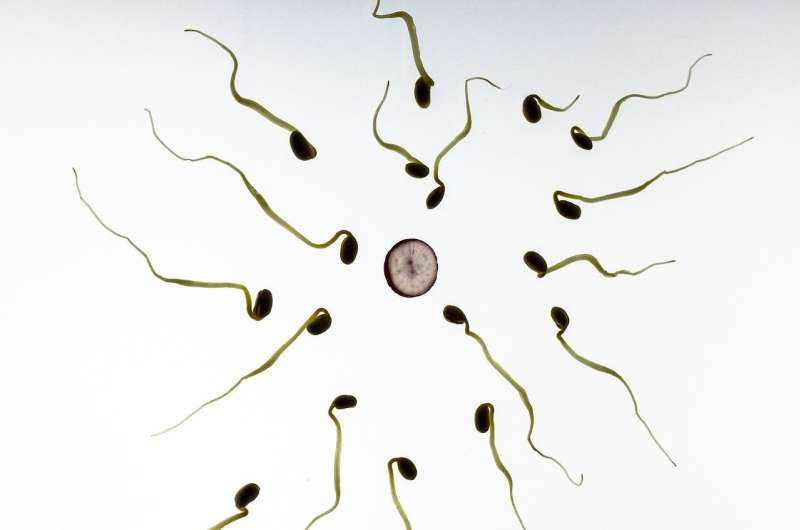
The three-dimensional structure of male germ cells determines how genomes evolve over time, according to a study led by scientists at the University of Kent. The study shows that the distinctive events occurring during egg and sperm cell production have a different impact on genome evolution and opens new research paths into the genetic origin of genome structure in all organisms.
A comparison of the genomes of many different mammals shows that the genes are arranged in different ways for different species and can be turned off. Gene function and regulation may be affected by these rearrangements and they may play a part in evolutionary changes. The ultimate origin of these rearrangements has been a mystery. Do they arise as a result of the normal reshuffling of genes between chromosomes that occurs during meiosis, the cellular process to produce gametes, or at some other stage in the life cycle?
A study led by scientists from the University of Kent and the University of Barcelona shows that sperm production is important to how regions of the genome are reorganized during evolution. After the meiotic cell divisions have completed, there are certain physical and biochemical processes that are specific to the final stages of sperm production.
The total sequence of DNA or genome of an individual is folded into a specifically tailored and dynamic 3D structure within the cell nucleus, which determines which genes are turned on and which are turned off in each cell type. Gametes are produced by all sexually reproducing organisms through a process called meiosis, which involves one round of genome replication followed by two consecutive cell divisions to leave haploid cells. During meiosis, genes are shuffled between the copies of the mother and father's genes. The genome must be packaged and unpackaged in a precise and highly regulated manner.
Our work shows that the dynamics of chromatin remodeling during the formation of male gametes is fundamental for understanding which parts of the genome are located close to each other inside the nucleus and are therefore more likely to be involved in chromosomal rearrangements.
Analyzing rodents' genomes.
The team compared the genomes of 13 different rodents and discovered the locations of the evolutionary breakpoints.
The regions that are active in later stages of spermatogenesis are associated with EBRs. Dr. Peter Ellis, Senior Lecturer in the School of Biosciences in the University of Kent, says that rearrangements occurring at EBRs were found to break and rejoin DNA stretches that are physically located close to each other in the spermatid nucleus.
The most likely reason for the absence of meiotic recombination hotspots in either males or females is that EBRs were not associated with them. The locations of DNA damage in spermatids were correlated with EBRs.
The final stage of sperm development is referred to as Spermatids, and it involves male-specific events. The implication is that males and females are not equal in their impact on genome evolution. The male germline is the overall engine of genome structural evolution according to Dr. Ellis.
We show that sperm cells retain their previous genome configurations. There are stretches of DNA that used to be part of a single rodents common ancestor but are now located on different chromosomes in a mouse, yet these still move close to each other and make physical contact.
Why in male germ cells?
There are different events that occur during egg and sperm cell production. During meiosis, sperm and egg cells rearrange their genes, but the breaks they create are repaired very accurately. Sperm cells have to compact their DNA into a small volume to fit in the sperm head. Error prone methods are used to repair the broken DNA. There are some errors that can cause genomic rearrangements, which explain why sperm development is a critical factor in genome evolution.
Some species have very stable genomes with few rearrangements, while others have highly dynamic genomes with multiple rearrangements.
Spermatogenesis is a highly conserved process, and therefore this principle is likely to apply throughout the tree of life, according to researchers.
The research teams from Josep Carreras Leukaemia Research Institute and Sequentia Biotech were involved in the study.
More information: 3D chromatin remodelling in the germ line modulates genome evolutionary plasticity, Nature Communications (2022). DOI: 10.1038/s41467-022-30296-6 Journal information: Nature Communications Citation: How do genomes evolve between species? Team explores the key role of 3D structure in male germ cells (2022, May 11) retrieved 11 May 2022 from https://phys.org/news/2022-05-genomes-evolve-species-team-explores.html This document is subject to copyright. Apart from any fair dealing for the purpose of private study or research, no part may be reproduced without the written permission. The content is provided for information purposes only.